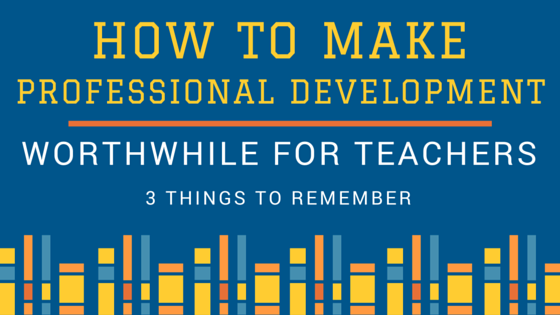 As I sit here and write this blog, I am at a district mandated professional development (PD) day…
As I sit here and write this blog, I am at a district mandated professional development (PD) day…
Yup…you guessed it, more downtime than productivity or learning. I am currently residing in the equivalent of adult babysitting. For professional development to be worthwhile for a teacher it needs to provide them with value. In order to increase that value and eventually the success of any training there are 3 things you should keep in mind.
STEP 1: Respect the Time of your Teachers.
Time is perhaps one of the most important resources for any teacher. We provide extra time at schools, donate it to grade papers and develop lesson plans and curriculum, and we never have enough of it. In fact, I would wager that if you ask any teacher what they wish they had more of, they would say “time”.
When you are providing PD for your staff, make sure you are on (or ahead) of schedule and there is very little wasted time. Make sure the purpose and value of the training or information is explicit and that you are valuing the time each individual teacher is taking to learn from the presenter or facilitator. If you begin to waste peoples’ time or “fill” time with things that are unnecessary or not valued by the staff you are training, they will quickly lose interest and even discount prior information that could have been useful. It’s also helpful to begin every session by thanking them for taking the time (even if mandatory) to participate.
STEP 2: Show Them Something New
If you show your staff a trick or concept they can use tomorrow, they will be more likely to hear what you have to say about the “long term” strategies or implementation processes. I often open my sessions with a survey using an app or strategy I have used with students. Not only does it allow me to gain valuable information and start a conversation, but many times, the activity itself is valuable to the teachers in the room. By beginning training this way, even if the concept is a larger endeavor or a long term strategy, they will have gotten something out of the training. This also increases their trust for the meatier parts of the training so you can keep them engaged.
STEP 3: Make it Relevant
If teachers can’t use it in their classroom, chances are they DO NOT care. It doesn’t matter how many studies or books have been written, or how many letters are after your name, if they can’t apply what you are presenting in their classrooms, they will ignore it. Regardless of the topic, strategy, or information you are trying to convey, make sure you are explicit in the “big picture” and how it all comes together for the individual teacher in their classroom. Make this a rule-of-thumb whenever giving examples or discussing information to make it matter to the people that have given their time up to hear it. Always ensure that you are tying in your topics with discussions or specific classroom examples. This will increase engagement and buy-in from your audience.
There are many other things that make PD better and more effective, but if you start with these 3 you will at least be able to avoid a hostile room or worse…a teacher uprising!
In todays world of mandates and the changing pressures of education, especially on teachers, make sure you are making the time you spend with them worthwhile!
Have any good (or bad) PD stories you want to share? shoot me an email!



